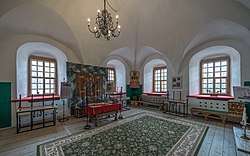Prikaz
In Muscovy and in Russia from the 15th to the 18th centuries, a prikaz (Russian: прика́з, prikaz; IPA: [prʲɪˈkas] (![]()


Most of the prikazes were subordinated to the Boyar Duma. Some of them (palace prikazes (Russian: дворцовые приказы)) were subordinated to the taynyi prikaz or pervyi prikaz, which answered directly to the tsar. The patriarch of Moscow and All Russia had his own prikazes.
There was a large number (up to 60) of specialized prikazes. The set of prikazes varied over time.
List of Russian prikazes
- Foreign affairs
- Ambassadorial Prikaz (Posolsky Prikaz) - in charge of international affairs, a kind of a Ministry of Foreign Affairs
- Captive Prikaz, (Polonyanichy Prikaz from archaic Russian: полон, плен 'polon', 'plen' means "captive"), for the redemption of Russian captives and prisoners of war
- Prikaz of Pans (Panskiy Prikaz) - office of Polish affairs
- Administrative
- Prikaz of the Seal (Pechatny Prikaz) - placed the tsar's seal on various documents granting various things to private individuals, and collected the corresponding duties
- Stone Prikaz (Kamennyi Prikaz)
- Coachman Prikaz (Courier Prikaz, Yam Prikaz: Yamskoy Prikaz)
- Book Printing Prikaz
- Prikaz of Hospice Construction
- Pharmaceutical Prikaz (Aptekarskiy prikaz)
- Monk Prikaz (Monasheskiy Prikaz)
- Judicial Prikazes
- Military Prikazes
- Prikaz of Riflemen (Streletsky Prikaz)
- Artillery Prikaz , (Pushkarsky Prikaz)
- Prikaz of Admiral, (Admiralteysky Prikaz)
- Prikaz of Cossacks (Kazachy Prikaz)
- Armored Prikaz (Bronniy Prikaz)
- Conscription Prikaz (Prikaz sbora ratnykh i datochnykh lydei (Russian: сбора ратных и даточных людей)
- Prikaz of Foreign Lands (Inozemsky Prikaz)
- Arsenal Prikaz (Oruzheiniy Prikaz)
- Preobrazhensky prikaz (ru), which oversaw Preobrazhensky and Semyonovsky regiments in the 18th century
- Prikaz of German feeds: probably, paid a salary to foreigners (known as "Germans" (Russian: немцы 'niemtsy' means "mute people")) in Russian military or state service
- Ritter Prikaz
- Financial Prikazes
- Domestic Prikaz (Pomestny Prikaz)
- Accounting Prikaz
- Prikaz of Grand Treasury
- Prikaz of Grand Income
- Security
- Prikaz of Petitions (Chelobitny Prikaz) - considered complaints or petitions addressed to the Tsar; the adjective chelobitnaya (Russian: челобитная) comes from the expression bit' chelom, "to knock with one's forehead (on the ground)", meaning a very humble submission of a petition, with an extremely low bow. The standard form of such complaint included the words "Slave of God ... (or: 'Your slave') is beating with the forehead", or "Slaves and orphans are beating with foreheads"
- Privy Prikaz (Prikaz tainyh del, Tayny Prikaz) - secret police
- Robbery Prikaz (Razboiniy Prikas) - criminal police
- Prikaz of Investigations (Sysknoy prikaz)
- Regional Prikazes
- Little Russia, Ministry of the Ukrainian (Malorossiya) Affairs (Малороссийский приказ, Malorossiyskiy prikaz)
- Kazan (Казанский приказ, Приказ Казанского дворца, Kazan Palace Prikaz ), Volga Region (Поволжье) Affairs (South-West of Russia, territories of Kazan Khanate)
- Siberia
- Great Russia
- Grand Duchy of Lithuania
- Smolensk (disbanded on Poland's conquest of Smolensk (1611); restored when Smolensk returned to Russian control in 1654)
- Livonia Affairs
- Novgorod quarter
- Vladimir quarter
- Ustug quarter
- Kostroma quarter
- Galich quarter
- Smolensk quarter
- Palace Prikazes
- Prikaz of Stables Konyushenny Prikaz
- Palace Prikaz (Dvortsovyi Prikaz)
- Prikaz of Stone Palace (Prikaz kamennogo dvortsa)
- Prikaz of Gold and Silver Affairs
- Prikaz of Requiem (Panihydniy prikaz) - requiems for members of the tsar's family
- Patriarchal Prikazes
- Patriarchal Prikaz-in-charge
- Patriarchal Treasury Prikaz
- Patriarchal Palace Prikaz
- Other
Origin
Originally, prikazes were created by private orders (Russian: приказ, prikaz) given by the tsar to a certain person. In some cases new orders bore the name of this person (Order of dyak Vakhromeyev, where 'Vakhromeyev' is a last name).
From 1512 on 'Prikaz' was starting to be used as a name of constant offices.
Classification
The classification of the various prikazes is a very difficult task. In fact, each major historian tries to build their own system of classification. Major variants include prikazes of a territory, of a class of population, or of an area of affairs. Another method of classification is to rank prikazes by subordination.
Abolition
The prikazes were abolished by Peter the Great and replaced, beginning in 1717, with administrative organs known as collegiate.
This process took a rather long time; the Siberian Prikaz, for example, was restored in 1730 and existed till 1755. At the beginning of the 18th century Peter the Great even established some new prikazes. The system was only fully eliminated by Catherine the Great in 1775.